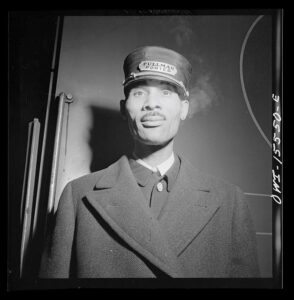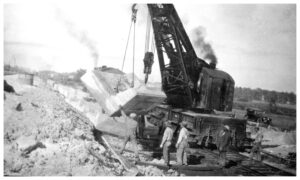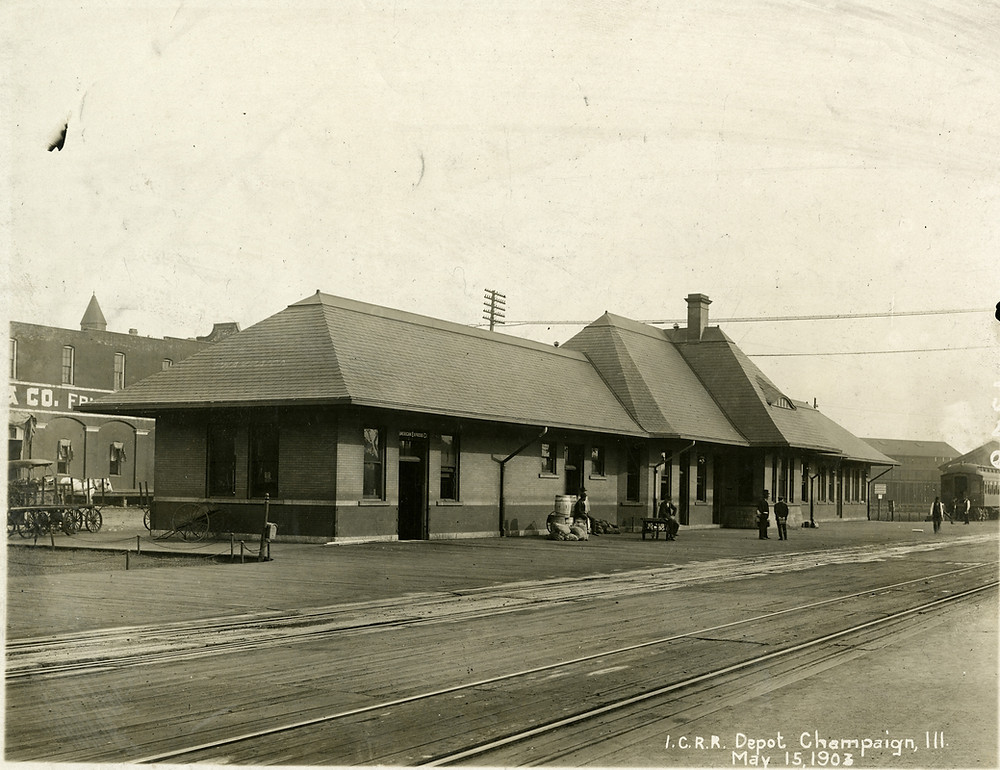African Americans and the Illinois Central Railroad
320 N. Chestnut Street, Champaign, IL
Chartered in 1851, the Illinois Central Railroad was lobbied for by both Steven A. Douglas and Abraham Lincoln. Completed by 1856, it was considered the longest railroad in the world. From 1857 through the Civil War, the Illinois Central Railroad (IC) was said to carry fugitives from slavery, along with the Chicago, Burlington and Quincy, and the Chicago and Rock Island Railroads. Fugitives travelled by box cars and passenger cars, by day and by night. With the assistance of railroad porters, sympathetic conductors, laborers, freedmen, and abolitionists, they managed to travel mostly without arrest.
The IC became the speediest way to reach Chicago. From Chicago, enslaved fugitives traveled by ship to Canada. Its terminus, Cairo, Illinois, was already a transfer station for those arriving via the Mississippi River and points south. Even before the IC’s completion, Cairo’s participation in the Underground Railroad was denied as seen in the Cairo City Times’ article on February 7, 1855. It stated that,
“The impression has gone abroad that there is to be an Underground railroad from this place to Chicago, and that negroes will be induced to run away from Missouri and Kentucky. We assure our friends abroad that such fears are entirely without foundation.”
However, George L. Burroughs, an African American agent on the Underground Railroad confirmed IC’s role in a 1896 letter. While a passenger car porter on the Chicago to Cairo route, he assisted fugitives traveling north via the railway beginning in 1857. Other confirmations came from Chicago newspapers. For example, on Tuesday, December 15, 1859, the Chicago Daily Democrat reported on two ‘negroes’ who escaped from Kentucky arriving in Chicago on the Illinois Central Railroad the preceding Tuesday night. Champaign County’s connections to IC’s role in the Underground Railroad included Benjamin Franklin Nash Sr. (1830-1906), an African American porter on the Chicago to Cairo who settled in Champaign in 1862. In 1863 he married Sophia Savers Butler who had escaped slavery only a few months before, coming directly to Champaign via the IC. Another was Mathais Lane Dunlap (1814-1875). A noted horticulturalist, he owned a nursery in Savoy. It’s said he hid fugitives in his basement and moved them north on the IC from a small depot on his property.
After the Civil War, many African Americans came to Champaign and found employment at the Doane House, which doubled as the Illinois Central depot. Their jobs included janitors, cooks, domestics, yardmen, and porters loading cargo and baggage. Others worked directly for the IC. Known collectively as trainmen, they worked as laborers, linemen known as Gandy Dancers [1] who laid and repaired the tracks; firemen who stoked the steam engines’ fires and controlled the steam’s presser; and brakeman who manually applied the brakes on each car by jumping from car to car while the train was in motion. They were the most labor intensive and dangerous jobs. Prior to safety improvements, brakemen and firemen were almost exclusively African Americans. This was a pattern set during slavery in the South where enslaved laborers, both men and women, were used to build, and maintain the railroads.
Black trainmen worked and lived, not just in Champaign-Urbana but in depot towns along the Illinois Central’s route with their families. For example, in 1870 one was found in both Rantoul and Tolono. As additional railroads crisscrossed the county, Black railmen were found in almost every depot town in the county. At the turn of the 20th Century with the rise of Jim Crow, and as African Americans began to compete for a variety for additional positions, violence erupted against them in the South. In the early nineteen hundreds at the Memphis District of the Illinois Central, their white co-workers were shooting them off trains, and in the train yards as they worked. To counter this violence and unfair employment practices, in 1912, Thomas Redd, a brakeman for IC formed the Association of Colored Railway Trainmen and Locomotive Firemen. Representing 15,000 workers at its peak, it was the first African American labor union in the nation. In 1920 with the help of the lawyers of the National Association of the Advancement of Colored People (NAACP) the union won a pay increase for African American trainmen of approximately $12.53 per month ($194.40 in 2023). Unfortunately, in retaliation their fellow white trainmen in Tennessee and Mississippi threaten them with lynching and placed a $300.00 bounty on any ‘colored’ trainman of the IC who accepted equal pay with their white counterparts. Several men lost their lives. Despite the violence, for the most part Black trainmen retained their jobs with many moving north. During the heyday of rail travel, the IC increased its African Americans employees. They acted as section men, switchmen, mechanics, machinists, and in railroad car repair. Women’s jobs included cleaning passage cars, doing laundry, working as attendants and cafeteria help. In Champaign a few worked in the Illinois Central’s greenhouse that provided produce to the trains dining cars from 1909 to 1924. It was located along Washington Street west of the track. During WWII they became track walkers and linemen. With the Civil Rights era, both men and women moved into administrative support and supervisory positions.
Railroad jobs enabled many African Americans to move away from subsistent jobs of sharecroppers, day laborers and field hands. Despite the struggle of mostly earning less than their white counterparts, these jobs gave them steady employment, and the ability to plan for the future. An example was Henry Simpson (b. 1860). Born into slavery, he went from farmer laborer to working in a Roundhouse in South Fulton, Tennessee. By 1919, he had migrated to Champaign where he became a switchman, overseeing the railroad transfer station at the intersection of the Illinois Central and the Big 4 rail lines at Market Street. His sons Fred and William Simpson worked for the IC repairing railroad cars. With their earnings, they were able to save, buy homes, raised families, and support their church – respectable members of Champaign-Urbana’s Black community. Ora T. Edwards (1898-1975) of Champaign, supervised the cleaning of passenger cars. She and her husband Richard Edwards Sr. became noted members of the community.
Pullman Porters played an important role on the Illinois Central Railroad’s passenger lines. Under the title’s umbrella were porters, maids (sometime called Porterettes), cooks and waiters providing the services of valets, baggage handlers, chambermaids, nannies, lady’s maid, chefs, line cooks, bartenders, and confidants. Working long hours, they provided all the amenities of an upscale restaurant, hotel, and lounge with unparalleled service. Established in 1867 by Chicagoan George Mortimer Pullman to service his Pullman Sleeping Cars, he first hired only formerly enslaved men. Questioned as to his hiring practices Pullman stated that “(t)he old Southern colored man makes the best porters.” He wanted to emulate his concept of the ‘perfect’ Southern servant who catered to the passengers’ every need, who took orders without question, provided top service and was discreet. By its very nature, the position perpetuation of the American ideal of plantation life was demeaning. The men were called George by the passengers, no matter what their name. This harkened back to chattel slavery where an enslaved person’s humanity was defined by their masters. By 1893 Pullman had over 2000 sleeping and dining cars and each had a full complement of porters, cooks and wait staff. By the 1920s the Pullman Company employed over 20,000 African American. It was largest private employer of African Americans. While it perpetuated negative stereotypes of African Americans in employment practices and advertisement, to counter act this the Brotherhood of Sleeping Car Porters and Maids was established in 1925, by A. Philip Randolph. Over the years through negotiations and lawsuits, the union was able to successfully lobby for greater economic opportunities and equality.
Despite the negative aspects, being a Pullman Porter was an admirable career in Black communities including Champaign-Urbana. Commanding slightly higher wages than most positions available, it provided employment stability, a means to buy a home, and upper mobility. Lessons learned through their exposure to the white intelligentsia, upper and middle class was passed down, helping to shape the Black middle class. One such example was Benjamin Franklin Stovall Sr. of Champaign. In the 1930s he and his sons Robert Lee and Benjamin Jr. were waiters with the Pullman Company on the Illinois Central Railroad. Through their jobs they were able to buy property, provide their children and grandchildren with college educations. They also housed Pullman Porters at their family home at 103 E. Church Street, Champaign, from the 1940s through the 1950s, converting an attic loft into a dormitory.
Traveling all train routes throughout the county, Pullmen Porters played a vital role in the Great Migration (1914-1941). With the outbreak of WWI, an increased demand for workers to support the war effort was met by a decrease of European immigration. This caused labors shortages in industrialized areas and provided new job opportunities for African Americans. News of these opportunities came south through newspapers carried by Pullman Porters along routes including Illinois Central’s Panama Limited line, which ran from Chicago to New Orleans, and were distributed or handed down from town to town. Hearing of these opportunities, African Americans moved north, along the IC, with a promise of higher wages, housing, education, and a better life away from sharecropping, harsh Jim Crow laws and violence. Many stopped and stayed in Champaign-Urbana, expanding the Black community from 876 in 1910 to 2,106 in 1940, doubling its population.
Through their unions founded in 1912 and 1925 respectively, African American trainmen and Pullman Porters developed strategies not just to pursue workers’ rights, but also social and civil justice, laying a pathway for the Civil Rights Movement.” In 1963, A. Philip Randolph organized the August March on Washington for Jobs and Freedom (known as the March on Washington), propelling Dr. Martin Luther King on the international stage.

Pullman Porter at Union Station in Chicago, IL. January 1943.
Credit: Jack Delano, photographer, Library of Congress, Washington, DC.

Illinois Central Railroad track elevation slab yard.
Credit: The Champaign County Historical Archives at the Urbana Free Library
This trail stop is sponsored by: Jane Hays & Dave Downey
Sources:
“The African-American Railroad Experience,” An interview with Theodore Kornweibel courtesy of KPBS. San Diego, CA, 2010; Youtube site: https://youtube.com/watch?v=XpMs5Ak6fBU
“A Different View: Windows into Black History on the Railroad,” Makea King, From the B&O Railroad Museum . . ., Friday, July 10, 2020; http//borailroad.blogspot.com/2029/07/a-different-view-window-into-black.html?m=1
Cairo City Times, February 7, 1855
“The Case of the Colored Trainmen: WWI and Racial Justice on the American Railroads,” by Albert Churella, Southern Polytechnic State University, 2014; Academia.edu; presented at the International Association for the History of Transport, Traffic and Mobility on September 17, 2014.
“Illinois and the Underground Railroad to Canada,” by Verna Cadey, Illinois State Historical Library, Issue 23, 1917.
“Illinois Central Roundhouse and Freight Yard,” Champaign County History Museum, J.T. Blakeman, Posted December. 21, 2017, updated December 14, 2018; http://www.champaignhistory.com/post/illinois-central-roundhouse-and-freight-yard
Letter from George Burroughs sent to Wilbur H. Siebert, January 6, 1896. The Underground Railroad from Slavery to Freedom, Wilbur H. Siebert, MacMillan Company, New York, 1898.
Website: https://archive.org/details/undergroundrailr00sieb/page/n3/mode/2up
“Exhibit Shed Light on Railways’ Discriminatory History,” Jose Beduya, Cornell Chronicle (Cornell University), February 12, 2020; website: https://news.cornell.edu/stories/2020/02/exhibit-sheds-light-railways-discriminatory/history
Article on exhibition, “The Other Side of the Tracks: Discrimination and Mobility in the Railroad Industry.”
“Slavery and the Southern Railroads,” Railroad and the Making of America, University of Nebraska, website: https://railroads.unl.edu/topics/slavery.php
Railroad in the African American Experience: A Photographic Journey, Theodore Kornweibel, John Hopkins University Press, 2010.
“Showing Agency on the Margins: African American Railway Workers in the South and Their Unions 1917-1930,” Joseph Kelly, Labour/Le Travail, Vol. 71 (Spring 2013), pgs. 123-148; https://www.jstor.org/stable/24243986
The Underground Railroad from Slavery to Freedom, Wilbur H. Siebert, MacMillan Company, New York, 1898.
“The Chicago, Burlington and Quincy and the Underground Railroad,” The National Railroad Hall of Fame, videotaped interview with Owen W. Muelder, Knox College, posted March 7, 2019; https://m.youtube.com/watch?v=7omPY40451g
Underground Railroad in Western Illinois, Owen W. Muelder, McFarland and Company, September 2012.
“Working on the Railroad: Women,” The Historic Marker Database, a historic marker erected by the North American Railroad Foundation; https://www.hmdb.org/masp?m=135944
Note: For the backgrounds of the individuals mentioned research was done using city directories, family interviews, newspaper articles and census records.
Educational Support:
“The Pullman Porters and the Railcar: Nexuses of the Great Migration”, Smithsonian Institute Learning Lab, website: https://learninglab.si.edu/collections/the-pullman-porters-and-the-railcar-nexuses-of-the-great-migration/4fqNwRf1HNNNsEAK
[1] The line workers were known as “gandy dancers” because of use of songs and rhythm to create a choreographed team to systematically place wooden ties, lay steel rails and drive spike in unison.
Decade:
1850-1859
People:
- George L. Burroughs
- George Pullman
- Mathias Lane Dunlap
Location(s):
- Champaign, Illinois
Additional Champaign Trail Sites

